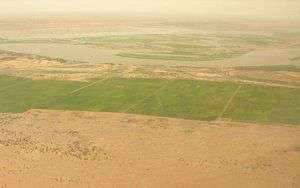Ségou Region
Ségou Region (Bambara: ߛߋߓߎ ߘߌߣߋߖߊ tr. Segu Dineja) is an administrative region in Mali, situated in the centre of the country with an area of 64,821 km2 (around 5% of Mali). The region is bordered by Sikasso Region on the south, Tombouctou and Mopti on the east, Burkina Faso to the southeast and the Koulikoro Region to the west. In 2009 it had 2,336,255 inhabitants, making it the second most populous region of Mali. Its administrative capital is the town of Ségou.
Ségou Region | |
|---|---|
 Location within Mali | |
| Coordinates: 13°22′5″N 5°16′24″W | |
| Country | |
| Capital | Ségou |
| Area | |
| • Total | 64,821 km2 (25,028 sq mi) |
| Population (2009 census)[1] | |
| • Total | 2,336,255 |
| • Density | 36/km2 (93/sq mi) |
| Time zone | UTC±0 (UTC) |
| HDI (2017) | 0.387[2] low · 4th |

Climate
The Ségou Region is characterized by a semi-arid climate (average yearly rainfall: 513 mm) and irrigated by two important waterways: the Niger and the Bani River, allowing irrigation for agriculture. Ségou has two seasons: a rainy season and a dry season. The rainy season starts in June and lasts about four months until September. On the other hand, the dry season includes a cold period and a period of heat. The average yearly rainfall is about 513 mm. The harmattan is the dominant wind in the dry season and it blows from north to south. The monsoon blowing from south to north-west is more frequent during the rainy season (hivernage).[3]
Demography
With a rural population that is largely nomadic semi-sedentary or sedentary, the population consists of many ethnic groups such as the Bambara, Bozo, Soninke, Malinké and Toucouleur. Bambaras are mostly farmers and are the most numerous ethnic group. Their language is Bambara or Djoula. The Bozos are the second most populous ethnic group. They live in the borders of Niger, in small towns constituted of small houses. The Bozos economy is based on fishing. Bozo people have a monopoly on the transport system because of their knowledge in the river by Niger, and are regarded as the masters of water. The Somono, also fishermen, are not a distinct ethnic group but a mixture of the Bambara, Bozo and Soninke. The Malinké, Maninka, and Mandinka are closely related to Bambaras. They have the same costumes, beliefs and religious practices as the Bambaras. The Marka, Saracollé and Soninke are merchants and warriors.
Economy
Today, Ségou is known for its pottery, market and fishing industry. Attractions in the old town of Ségou-Koro included a mosque, Coulibaly's tomb and an ancient tree. In the city center, the main landmark is the water tower.
The main economic activities of the Ségou region are agri-business, cattle farming and fishing. The Ségou people apply essential traditional farming methods. Ségou produces the major part of Mali's national food, including sedentary cattle farming. The economy is essentially informal as it is oriented towards the population's primary needs, while industrial production is weak and based in the food industry. Large scale agribusiness consists of three factories, COMATEX, CMDT and SUKALA. Commerce consists mostly of the small scale exchange and sale by of products from the primary sector, sold weekly at the large Ségou market, drawing customers from far outside of the city. The main products sold are vegetables, pottery, cotton, gold, leather, fruits, ovens, cattle and cereals.[4]
Administrative subdivisions

Ségou Region is divided into 7 cercles encompassing 118 communes and 2,166 villages:[5]
| Cercle name | Area (km2) | Population Census 1998 | Population Census 2009 |
|---|---|---|---|
| Bla | 6,200 | 202,295 | 283,663 |
| Barouéli | 4,170 | 157,145 | 203,550 |
| Macina | 11,750 | 168,853 | 237,477 |
| Niono | 23,063 | 228,264 | 365,443 |
| San | 7,262 | 250,597 | 334,911 |
| Ségou | 10,844 | 501,447 | 691,358 |
| Tominian | 6,573 | 166,756 | 219,853 |
Towns
The major towns are Ségou, San, Niono, Dioro, and Markala, the latter of which has Mali's principal hydroelectric dam.
History
See also History of Ségou and Bambara Empire.
The region was the home of the Bambara Empire of the early eighteenth century; it was later conquered by the Toucouleur Empire (1860s) and the French colonial army (1890s).
See also
References
- Resultats Provisoires RGPH 2009 (Région de Ségou) (PDF) (in French), République de Mali: Institut National de la Statistique.
- "Sub-national HDI - Area Database - Global Data Lab". hdi.globaldatalab.org. Retrieved 2018-09-13.
- Caractéristiques physiques Retrieved May 29, 2007 from http://region.segou.net/caracteristique.htm
- Activités économiques. Retrieved May 29, 2007 from http://region.segou.net/activit%E9s.htm
- Communes de la Région de Ségou (PDF) (in French), Ministère de l’administration territoriale et des collectivités locales, République du Mali, archived from the original (PDF) on 2012-03-09.
External links
- Synthèsis des 118 Plans Communaux de Securité Alimentaire de la Région de Ségou 2008-2012 (PDF) (in French), Commissariat à la Sécurité Alimentaire, République du Mali, USAID-Mali, 2008.
- L'économie locale de Ségou: Rapport général (in French), Ministère des Affaires Étrangères des Pays-Bas, Organisation for Economic Co-Operation and Development (OECD), 2000–2002.
- L'économie locale de Ségou: Comptes économiques locaux du Cercle de Ségou (in French), Organisation for Economic Co-Operation and Development (OECD), 2000–2002.
